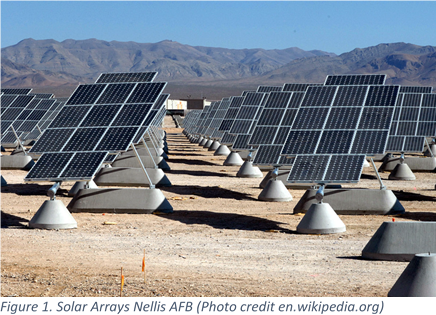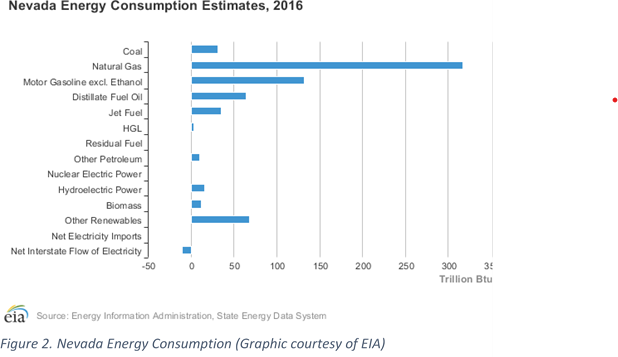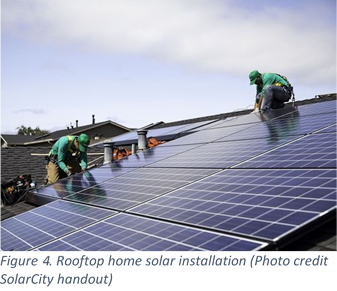In follow-up discussions about earlier NSF events, we were asked to develop the attached whitepaper focused on energy security issues in Nevada. This study outlines why energy generation and transmission are critical national security issues and how Nevada can lead the nation in developing more safe, secure and resilient energy supplies.

Energy Security in Nevada
Report Prepared by: Maureen McCarthy, PhD
Director, Programs & Commentary
National Security Forum of Northern Nevada
For more information about NSF please visit our website: https://nationalsecurityforum.org
or email us at: info@nationalsecurityform.org
“The National Security Forum of Northern Nevada (NSF) serves as a venue for thoughtful consideration of international, politico-military, and geo-economic issues. The NSF provides commentary representing diverse viewpoints and convenes periodic meetings to bring together experts representing a wide spectrum of opinions to address issues of current importance in a balanced and non-partisan manner.
Executive Summary
This whitepaper, prepared by the National Security Forum (NSF) of Northern Nevada, explores the national security implications of advanced energy generation and distribution in the state of Nevada. Energy security has been a topic of discussion at several NSF events. This paper summarizes some of those discussions along with key findings related to Nevada’s role in providing safe, secure and resilient energy technologies and supplies to residents of the state and the nation. Looking forward, Nevada has an opportunity to be a national leader in developing advanced energy resources, diversifying electricity generation and distribution, and meeting energy security goals for the state and the nation.
Key Findings:
- The Department of Defense (DoD) has invested substantial resources in renewable energy generation and distribution technologies in response to the national security imperative to improve the safety, security, and reliability of domestic and overseas operations.
- Large utility-scale solar arrays installed by DoD at Nellis Air Force Base enhance our national security and provide local communities with reliable, renewable energy.
- Nevada has the most solar energy potential of any state in the nation and is rich in other renewable energy sources including geothermal, hydroelectric, and wind. Tapping into this potential could bring economic and energy security benefits to the state.
- By capitalizing on distributed solar, geothermal, biomass, wind and hydropower projects, Nevada has the potential to support substantial growth in advanced energy, potentially producing up to 70-80% of the electricity needs for the state (up from 20-25% today).
- Increasing Nevada’s Renewable Portfolio Standard (RPS) would create more reliable and resilient energy generation and distribution in the state and could provide incentives for more advanced energy companies to establish or expand operations in Nevada.
- Rooftop solar projects are expanding in the state following the passage of AB 405 in 2017, creating over 6,000 jobs and generating over 80-megawatts of power.
- Nevada’s national security culture, academic research, development and training programs, and business environment position it to be a leader in the nation for advanced energy generation and distribution.

Energy Security is National Security
The Department of Defense (DoD) and all branches of the military has been investing in renewable energy generation to enhance combat effectiveness, improve the safety and security of operations, and reduce costs both domestically and overseas. Reducing the reliance on fossil fuels during mission critical operations has been a priority of DoD for decades. This effort became especially urgent in 2006 during the height of deployments during Operation Iraqi Freedom when U.S. logistics support convoys carrying diesel fuel and water became primary targets of insurgent attacks. Many U.S. casualties in Iraq resulted from these attacks. (Zilmer, 2018) Since then, DoD has stepped up the development of advanced energy sources to minimize vulnerable logistics operations, reduce the number of troops needed to protect and transport fuel supplies, and improve warfighter mobility (CNA Military Advisory Board, 2017).
Depending on location and operational requirements, advanced energy sources being developed and used by DoD include geothermal, wind, solar, biomass, nuclear, hydroelectric, and hydrogen cells. In addition to diversifying energy sources DoD is investing in a suite of energy storage-technologies and efficient and intelligent energy distribution systems. Several U.S. military bases including Nellis Air Force Base outside Las Vegas, have built large-scale solar arrays that supply energy for base operations with the excess power transferred to outside grids for civilian consumers (Figure 1).

From a national perspective advanced energy sources are not just an advantage militarily, but also economically. In 2015, China led the world in renewable energy production (nearly doubling the energy output of the United States) (CNA Military Advisory Board, 2017). Today, renewable advanced energy systems account for approximately 3 percent of the world’s total energy. Renewable energy market shares are expected to grow dramatically in the next decade as both the economic and environmental costs of fossil fuel extraction and burning increase and the cost of utility-scale renewable energy production decreases. Ensuring the United States remains a leader in the renewable energy lifecycle, from research and development to utility-scale generation and distribution, is an element of economic competitiveness that strengthens national security (American Council on Renewable Energy, 2018).
Protecting electricity transmission infrastructure as well as supplies is a critical element of energy security in the United States. The national grid system comprises more than 7,700 energy generation plants, 55,000 substations, 5.5 million miles of distribution lines, and over 3,300 public and private utilities that provide electricity to the American public. The value of the electricity supply chain is estimated around $1 trillion (U.S. Department of Energy, 2017). The vulnerability of the grid to both physical and cyberattacks has become more evident in the last several years. In 2018, the Department of Homeland Security reported that Russian military intelligence operatives hacked U.S. power plants and were directing efforts to implant malware in the grid (Sanger, 2018).
Increasing threats from natural disasters to cyber-physical attacks, to electromagnetic events prompted the President’s National Infrastructure Advisory Council (NAIC) to elevate this issue to the Administration in December 2018 and provide recommendations to mitigate the consequences from a regional to national scale disruption of power supplies in the United States. Recommendations from NAIC were organized into two areas: 1) design a national approach for catastrophic power outages, and 2) mitigate cross-sector interdependencies and cascading failures (The President’s National Infrastructure Advisory Council, 2018). Diversifying electricity grids could reduce vulnerabilities and add resilience to the electrical transmission system, helping to mitigate the risk of catastrophic cascading infrastructure failures.
Current Role of Renewables in Nevada
According to the U.S. Energy Information Administration as of 2016 approximately 87% of energy consumed in the State of Nevada came from outside the state (U.S.-EIA, 2018). In 2017, 70% of the State’s electricity generation came from natural gas with the largest generating plant recycling 75% of the water used for power generation (Figure 2). Nevada, comprised mostly of arid lands of the Great Basin and Mojave Desert, is the driest state in the nation mandating all forms of energy generation be water-conserving.

Nevada is rich in renewable energy resources with its arid lands providing the “most solar energy resource potential in the nation” (U.S.-EIA, 2018). Approximately 20% of the state’s electricity comes from renewables – solar, geothermal and hydroelectric. Nevada is home to the second highest geothermal energy generation in the nation and the fourth highest utility-scale solar energy generation .

(Figure 3). In 2018, Nevada ranked in the top five states in the country with solar electric installations. It is also one of very few states with utility-scale geothermal plants and is home to the nation’s only hybrid geothermal-solar photovoltaic (PV) power plant. Solar thermal energy boosts the geothermal fluid temperatures increasing the energy output to local energy generation in Nevada (U.S.-EIA, 2018).
Of particular note is the Moapa Southern Paiute Solar Project. Constructed in 2014, and operational in 2017, on the Moapa River Indian Reservation (adjacent to Las Vegas), it is the nation’s first utility-scale solar plant built on tribal lands. The tribe leased the land for the plant’s construction and receives proceeds from the energy sales. Two additional large-scale solar facilities are under construction in partnership with the tribe. The Moapa Band of Paiutes are one of 19 federally-recognized Native American groups in the state. Other tribes including the Washoe Tribe of Nevada and California (residing near Lake Tahoe) have installed solar PV facilities. The Pyramid Lake Paiute Tribe (adjacent to Reno) and the Walker River Paiute Tribe (in Schurz) both have significant geothermal energy resources that are being explored for development (U.S.-EIA, 2018)
Through a public-private partnership with SunPower Corporation and MMA Renewable Ventures, the Department of Defense constructed the largest solar PV plants in the country in 2007 at the Nellis Air Force Base outside Las Vegas (Figure 1). The 14.2-megawatt, 70,000 PV panel array provides 25% of the energy for base operations annually (100% during the summer months). A second solar array, operated by NV Energy, was completed in 2015 at Nellis AFB and provides additional power to the base with excess power made available to the civilian grid and used by Nevada customers (Citizens for Responsible Energy Solutions, 2018). Similar installations are being considered at Creech AFB, adjacent to Nellis AFB. A large-scale geothermal research project was also proposed near Fallon Naval Air Station through at partnership with Sandia National Laboratory (Ayling et al., 2018). However, this site was not selected for further development by the U.S. Department of Energy (USDOE) (Ranson, 2018). Providing reliable energy generation on military bases supports DoD’s goal of achieving safe, secure reliable energy for operations.
Nevada also houses one of the nation’s largest hydroelectric plants at the Hoover Dam, which produces energy for Nevada, Arizona and California. Wind power generation contributes significantly less to Nevada’s renewable portfolio with only one large-scale wind farm project in the state. One factor contributing to the lack of large-scale wind projects is the high percentage (around 80%) of the state’s land that is managed by the federal government (U.S.-EIA, 2018).
Rooftop solar installations contribute to local energy production in Nevada along utility-scale solar arrays (Figure 4). A report by NV Energy, released in December 2018, indicated that there were nearly 15,000 applications for rooftop solar projects in 2018, a 450% increase over 2017 (Misbrenner, 2019)(NV Energy, 2018) (Weaver, 2018). The growth was in large part due to the passage of Assembly Bill 405 (AB 405) by the Nevada Legislature in 2017. The bill created a consumer bill of rights for homeowners installing photovoltaic (PV) solar systems on their homes with energy output metered and transferred to local utility grids (Hanel, 2018). Net metering was mandated for 25-kilowatt or smaller PV systems, with surplus energy credited at 95% of the retail rate up to a limit of 80-megawatts total production (Weaver, 2018). Credits decline incrementally after the 80-megawatt tier is reached. Roof top solar installation projects achieved the 80-megawatt tier in late 2018. For reference, one megawatt of energy can typically power around 150 homes (Snyder, 2018). The rooftop solar industry has created over 6,000 jobs in the state as well producing energy (Snyder, 2018). Even though rooftop solar is less efficient and more costly (per kilowatt of energy produced) than utility-scale solar energy generation it does contribute economically to the state and contributes to meeting the state’s Renewable Portfolio Standard (RPS).

Nevada’s RPS was adopted by the State Legislature in 1997 (NRS 704.7801) and has been updated regularly. It requires that 20% of the State’s energy come from renewables today with the percentage increasing to 25% by 2025. Specific interim goals are also identified for solar energy capacity (NV-PUC, 2018). In November 2018, Nevadans voted to increase the RPS to 50% by 2030. Because this ballot initiative would amend the Nevada Constitution, it must be approved by Nevada voters a second time in 2020 and would go into effect in 2023. A similar measure to update the RPS and derive at least half of Nevada’s energy from local renewable resources is currently being considered by the Nevada State Legislature. Legislative action could accelerate the timetable for implementing the higher RPS.
Grid Diversification
In a seminal report authored by the CNA Military Advisory Board in 2015, vulnerabilities to the United States energy generation and distribution infrastructure (commonly known as “the grid) were identified as a major national security risk (CNA Military Advisory Board, 2015). A key finding of the report was the need for more secure, resilient and reliable energy supplies for the Department of Defense’s military installations in the country and a more robust distributed grid system nationally to ensure DoD can maintain readiness and execute mission critical operations.

Our national grid (Figure 5) is based on a design concept developed over a century ago; one that has been proven to be vulnerable to natural disasters and today’s technologically-savvy adversaries. Local communities across the country receive electricity almost entirely from large clustered power generating plants. This model requires electricity be transmitted over long-distances across exposed high-voltage infrastructure that can easily be disrupted by natural events (e.g., extreme storms, high winds, earthquakes) and malicious attacks.
The grid is also very rigid, typically transmitting power only in one direction and dependent on a limited number of critical nodes that if disrupted could cause the system to collapse regionally, or even nationally (CNA Military Advisory Board, 2015). The Federal Energy Regulatory Commission determined in 2014 that the loss of only nine nodes among the 55,000 transmission substations could result in catastrophic failure, creating a nationwide outage lasting weeks to months (Smith, 2014).
A major challenge to making distributed grid systems more effective requires building redundancy and sufficient storage capacity into the system to ensure reliable electricity is available to consumers around the clock. Introducing small modular nuclear reactors, commercial-scale hydrogen energy systems, and advanced energy storage systems into distributed grids in some locations could provide essential power backup needed to assure energy supplies (CNA Military Advisory Board, 2015).
The diverse mixture of public and private entities operating grids across the country also poses a challenge to implementing the distributed grid concept nationally. State and local jurisdictions along with private energy companies need to be coordinated and working in partnership on mutually-achievable plans and timelines in order to make the transition from national to distributed grid systems a reality. Advanced energy technologies from roof-top solar to utility-scale renewable energy power plants, advanced storage facilities, and smart-grid technologies will be needed to make distributed grids effective and reliable for communities across the country.
The new energy distribution concept being championed by DoD, known as “assured electrical power,” relies on a local and distributed generation, storage and energy usage. Networked distributed electrical grids across the country could provide significantly more flexibility and resilience, potentially even reducing costs for consumers. Technologically, the distributed or “micro-grid” concept has been demonstrated on relatively small-scales (i.e., military bases and other DoD installations) using renewable energy generation from sources such as wind, solar, geothermal, and hydroelectric (CNA Military Advisory Board, 2015). Several incidents involving physical attacks (in addition to many cyberattacks) on key substations have occurred in the last several years including the Metcalf incident in 2013, in which snipers disabled 17 transformers, operated by Pacific Gas & Electric (PG&E), that supply power to Silicon Valley (Harris, 2013).
Driven by the national security imperative, DoD has been leading large-scale renewable energy development and applying innovative and advanced technologies to produce and consume energy on their bases and transferring excess energy outside to local consumers. These technological advances can serve as a model for diversifying civilian energy distribution across the country and modernizing our antiquated national grid (Von Kaenel, 2016) (CNA Military Advisory Board, 2017) (CNA Military Advisory Board, 2015).
Nevada Actions on Grid Modernization
According to a November 2018 report by the NC Clean Energy Technology Center, on grid modernization across the 5 states, Nevada is among the states most actively working to enhance grid resilience (Proudlove et al., 2018). Actions taken include legislative and regulatory meausures ranging from requirements for smart grid and advanced metering to energy storage to microgrid installations to utility reforms. Nevada has conducted grid reform studies, developed planning and market access, implemented utility business model and rate reform measures, and implemented new policies to enhance grid modernization during the 3rd quarter of 2018. This indicates a strong commitment in the state acting to improve grid resilience and reliability.
The U.S. Department of Energy is actively supporting grid modernization in all 50 states through the GRID Modernization Laboratory Consortium with the goal of facilitating access by states and the private sector to advanced technologies for energy storage and distributed generation developed in partnership with DOE national laboratories (Grid Modernization Laboratory Consortium, 2018) (Schwartz, 2017).
Drivers for Advanced Energy Development Nevada
Several factors support Nevada’s growing leadership role in advanced energy development including its national security culture, economic growth goals, academic institution capabilities, and business environment. Tapping into this potential could bring economic and energy security benefits to the state. Looking forward, Nevada has an opportunity to be a national leader in developing advanced energy resources, diversifying electricity generation and distribution, and meeting energy security goals for the state and the nation.
National Security Culture: Nevada is well-positioned to continue and expand its role as a leader in providing safe, secure and resilient energy for the state and the nation. The state has a long-standing culture steeped in national security that makes it uniquely positioned to realize innovative technical and policy solutions for advanced energy generation and transmission that are resilient to disruptions from emerging threats and natural disasters. Unique to Nevada are its established partnerships with federal national security agencies including the Departments of Defense and Energy. Mission critical military operations are conducted on numerous bases throughout the state. Nevada is also home to the nation’s only field-scale nuclear security and stockpile stewardship test facility, the Nevada Nuclear Security Site, a 1350 mi2 reservation located northwest of Las Vegas.
Economic Growth: Affordable, reliable renewable energy production has been driving economic development in Nevada. A 2015 report, “Powering Up Nevada: A Report on the Economic Benefits of Renewable Electricity Development,” identified several current and future actions associated with renewable energy generation and distribution that can contribute to economic growth, energy independence and job creation in the state, including raising the state’s RPS to bring additional utility-scale renewable development investments (A Renewable America, 2015). By capitalizing on new public and private solar, geothermal, biomass, wind and hydropower projects, Nevada has the potential to support substantial growth in advanced energy, potentially producing up to 70-80% of the electricity needs for the state (up from 20-25% today) (A Renewable America, 2015).
Academic Research, Development & Training: The Nevada System of Higher Education supports a robust portfolio of advanced energy development research and development (R&D) at the University of Nevada, Reno (UNR), the University of Nevada, Las Vegas (UNLV), and the Desert Research Institute (Desert Research Institute, 2016). Numerous clean energy technical training programs in areas including solar photovoltaic installation, wind project siting and construction, geothermal power plant operations, are offered at Truckee Meadows Community College (TMCC), College of Southern Nevada, UNR, UNLV, and others in the NSHE System (Truckee Meadows Community College, 2018). In addition, NV Energy supports an apprenticeship program in energy operations (NVEnergy, 2017). By leveraging these capabilities, Nevada has an opportunity to train its workforce to participate in the next innovations that will strengthen and diversify the electrical grid.
Business environment: Nevada’s business environment has received conflicting ratings for its “favorability” for starting and operating a business from a very high ranking in 2016 (Depietro, 2016) to a less favorable rating in 2018 (Depietro, 2016) (Sauter et al., 2018). The tax structure in Nevada is favorable to individuals and businesses; however, the state faces challenges meeting the demands for STEM educated workers necessary to attract large-scale advanced energy development projects (Sauter et al., 2018). The Governor’s Office of Economic Development supports programs that provide incentives for industries to locate (or relocate) to Nevada including offering competitive utility rates for commercial operations (Nevada GOED, 2018). Increasing the RPS would create more reliable and resilient energy generation and distribution in the state could also provide incentives for more advanced energy companies to establish or expand operations in Nevada.

References:
A Renewable America. (2015). Powering Up Nevada: A Report on the Economic Benefits of Renewable Electricity Development. Washington, DC. Retrieved from http://energy.nv.gov/uploadedFiles/energynvgov/content/Media/DGA_Report_NV_v5_SMALL.PDF
American Council on Renewable Energy. (2018). The Role of Renewable Energy in National Security. Retrieved from https://acore.org/wp-content/uploads/2018/10/ACORE_Issue-Brief_-The-Role-of-Renewable-Energy-in-National-Security.pdf
Ayling, B., Blankenship, D., Sullivan, P., Kennedy, M., Majer, E. L., Villavert, M., et al. (2018). Phase 2 Update for the Fallon FORGE Site, Nevada, USA. In PROCEEDINGS, 43rd Workshop on Geothermal Reservoir Engineering, February 12-14, 2018 SGP-TR-213. Standford University. Retrieved from http://esd1.lbl.gov/research/projects/induced_seismicity/egs/fallonforge.html
Citizens for Responsible Energy Solutions. (2018). Defense Spotlight: Nellis AFB Leads by Example in Solar Energy. Retrieved February 27, 2019, from https://www.citizensfor.com/defense-spotlight-nellis-afb-leads-by-example-in-solar-energy/
CNA Military Advisory Board. (2015). National Security and Assured U.S. Electrical Power. Arlingiton, VA. Retrieved from https://www.cna.org/cna_files/pdf/national-security-assured-electrical-power.pdf
CNA Military Advisory Board. (2017). Advanced Energy and U.S. National Security. Arlingiton, VA. Retrieved from https://www.cna.org/CNA_files/PDF/IRM-2017-U-015512.pdf
Depietro, A. (2016). The best and worst states to start a business. Retrieved from https://www.businessinsider.com/the-best-and-worst-states-to-start-a-business-2016-10#-48
Desert Research Institute. (2016). Conference Proceedings NVREC Contacts and Collaborations. Retrieved from http://www.dri.edu/conference-proceedings/171-programs/nevada-renewable-energy-consortium
Grid Modernization Laboratory Consortium. (2018). Retrieved from https://www.energy.gov/grid-modernization-initiative-0/grid-modernization-lab-consortium
Hanel, S. (2018, March 2). Rooftop solar rebounds; still faces challenges. Las Vegas Review-Journal.
Harris, S. (2013, December). “Military-Style” Raid on California Power Station Spooks U.S. Foreign Policy. Retrieved from https://foreignpolicy.com/2013/12/27/military-style-raid-on-california-power-station-spooks-u-s/
Von Kaenel, C. (2016). Energy Security Drives U.S. Military to Renewables. Scientific American.
Misbrenner, K. (2019, January 31). New report shows 450% growth in Nevada rooftop solar applications in 2018. Solar Power World. Retrieved from https://www.solarpowerworldonline.com/2019/01/new-report-shows-450-percent-nevada-solar-growth/
Nevada GOED. (2018). Nevada Governor’s Office of Economic Development. Retrieved from http://www.diversifynevada.com
NV-PUC. (2018). State of Nevada Public Utilities Commission. Retrieved February 27, 2019, from http://puc.nv.gov
NV Energy. (2018). December 2018 RenewableGenerations Monthly Report Ecosystem of Clean Energy Programs December Contractor Training Webinar. Retrieved from https://www.nvenergy.com/publish/content/dam/nvenergy/brochures_arch/cleanenergy/renewable-energy-incentives/monthly-report/December-2018-RenewableGenerations-Report.pdf
NVEnergy. (2017). NVEnergy Appreticeship Programs. Retrieved from https://www.nvenergy.com/about-nvenergy/careers/apprenticeships
Proudlove, A., Lips, B., & Sarkisian, D. (2018). 50 States of Grid Mondernization Q3 2018 Quarterly Report Executive Summary. Retrieved from https://nccleantech.ncsu.edu/wp-content/uploads/2018/10/Q32018_gridmod_exec_final.pdf
Ranson, S. (2018, July 5). D.O.E. passes over Fallon geothermal site for research.
Sanger, D. E. (2018). Russian Hackers Appear to Shift Focus to U.S. Power Grid. New York Times. Retrieved from https://www.nytimes.com/2018/07/27/us/politics/russian-hackers-electric-grid-elections-.html
Sauter, M., Comen, E., & Stebbins, S. (2018, February 28). The Best (and Worst) States for Business. 24/7 Wall Street.
Schwartz, L. (Lawrence B. N. L. (2017). Planning for the Evolving Grid: State Distribution Planning Practices. In National Conference of State Legislatures. U.S. Department of Energy, GRID Moderniation Laboratory Consortiumm. Retrieved from http://www.ncsl.org/Portals/1/Documents/energy/webinar_LSchwartz_9_2017_31633.pdf
Smith, R. (2014, March 12). U.S. Risks National Blackout from Small-Scale Attack: Federal Analysis Says Sabatoge of Nine Key Substations is Sufficient for Broad Outage. The Wall Street Journal.
Snyder, R. (2018, July 5). Rooftop solar installations nearing trigger for lower reimbursement rates. The Nevada Independent.
The President’s National Infrastructure Advisory Council. (2018). Surviving a Catastrophic Power Outage. Washington, DC. Retrieved from https://www.dhs.gov/sites/default/files/publications/NIAC Catastrophic Power Outage Study_508 FINAL.pdf
Truckee Meadows Community College. (2018). Energy Technologies. Truckee Meadows Community College. Retrieved from http://www.tmcc.edu/applied-technologies/programs/energy-technologies/
U.S.-EIA. (2018). U.S. Energy Information Administration Nevada State Profile and Energy Estimates. Washington, DC. Retrieved from https://www.eia.gov/state/index.php?sid=NV
U.S. Department of Energy. (2017). Valuation of Energy Security for the United States. Retrieved from https://www.energy.gov/sites/prod/files/2017/01/f34/Valuation of Energy Security for the United States %28Full Report%29_1.pdf
Weaver, J. (2018, May). Net metering drives rooftop solar resurgence in Nevada. PV Magazine. Retrieved from https://pv-magazine-usa.com/2018/05/07/net-metering-in-nevada-once-again-shown-as-solar-power-winner/
Zilmer, R. C. (2018). Energy Security, Renewables, and Why the U.S. Military has Gone Green. Retrieved from https://nationalsecurityforum.org/2018/06/


